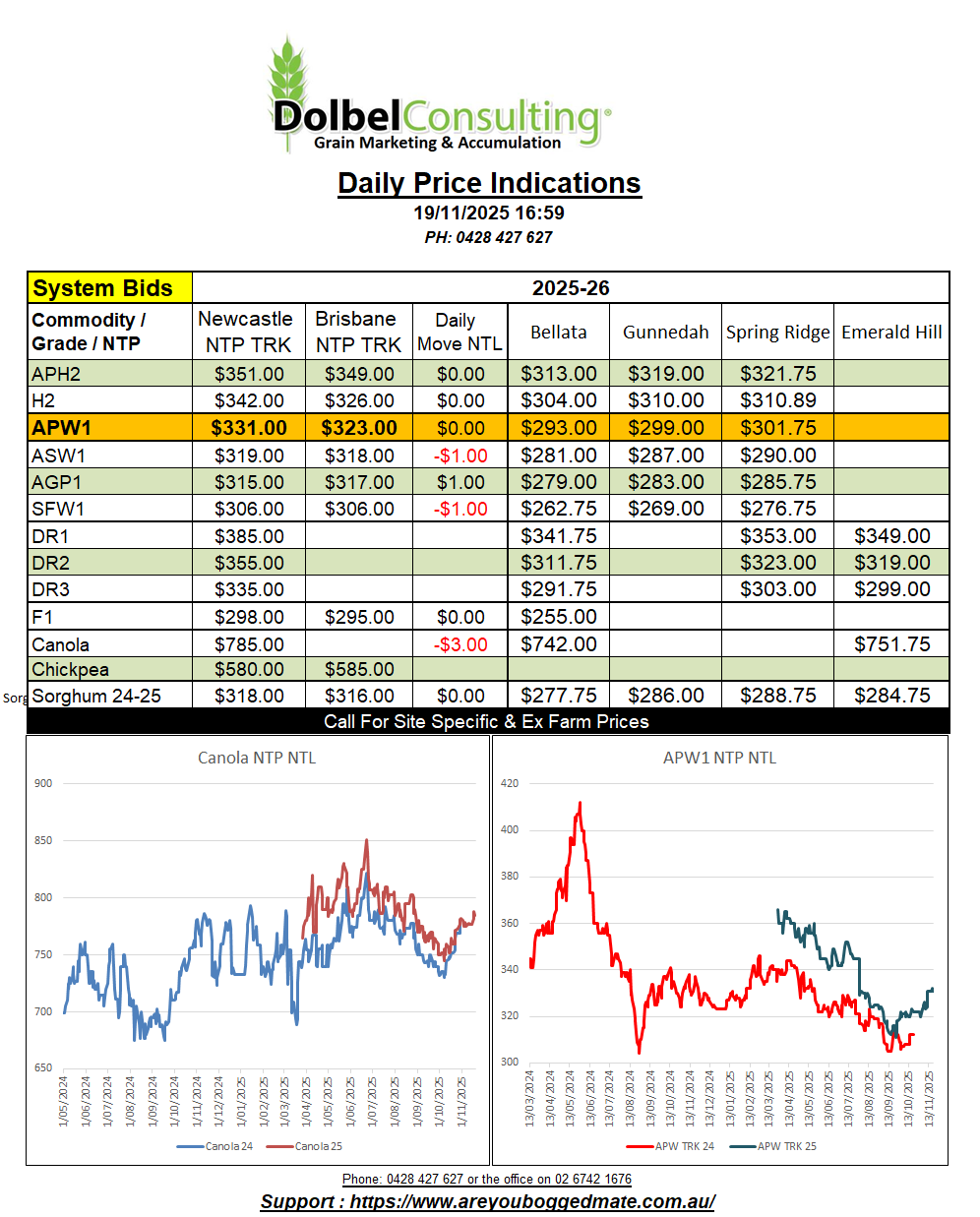19/11/25 Prices

US grain futures showed little of the strength of Monday’s session in the Tuesday session. US wheat futures didn’t collapsed, but the moves in both soft red winter wheat and hard red winter wheat were mediocre. Spring wheat fared a little better, the higher protein market making some gains but nothing to write home about. Corn at Chicago was a smidge higher nearby and soybeans were weaker across the board.
This leads us to canola and rapeseed. Paris rapeseed has been the leading indicator for Aussie canola values for a while now. Unless Aussie export volume to China or other markets increases dramatically, and we find less Aussie canola being shipped to the EU this is unlikely to change. Thus it is prudent for us to look closely at both basis to Paris rapeseed futures and at the carry that is in that market.
Presently we see nearby rapeseed futures priced at €485 for the Feb 26 slot, €482.50 for the May 26 slot and €467.75 for the August 26 slot. The August slot is more reflective of the EU new crop. The market is inverse, nearby canola is worth more than outer month canola. This is telling the market they want canola now, not so much in May and by August new crop has them covered and carry is then getting put back in the market. Nov 26 closed at €470.25.
Interesting to note this is not the case for Winnipeg canola, the below table shows that is a carry market, nearby values are less than outer month values. This tells you that the market is telling sellers to hold their stock and sell later. There is plenty of stock nearby. The USDA confirmed this in Friday’s WASDE when they increased Canadian canola production from 20mt to 21.7mt. Australian production was also increased from 6.4mt to 6.7mt. Time will tell if this is correct for Australia, but I have my doubts after talking to farmers and getting actual yields. The USDA increased global canola production to 92mt.
Current strength in the canola market is from a couple of major political events. China’s import tariffs on Canadian canola and the potential for an increase of US soybeans to China. The later possibly taking US soybean exports to their average export volume to China. Not exactly fundamentally bullish factors.
Local traders were having none of the move in US wheat futures yesterday. How dare they not move local prices higher, in the middle of harvest, on the back of a technical market correction with little to no fundamental backing. I’m probably being a bit to cynical but I did expect to see some upside, just a few bucks, not the whole $12.00. Even a jump because of the lower dollar would have appeased me, but that was not to be.
Basis to Chicago futures was crushed, falling from +61c/bu to about +47c/bu. A 14c/bu fall in basis alone was equivalent to not rising local bids AUD$7.93/t yesterday. Overnight the AUD has moved higher against the USD, and most of our major trade partners. If you ever wanted to visit Japan now’s probably a good time, at 101.39 it at least makes currency conversions easy.
One would expect that if the local trade did not follow the market higher yesterday, then they will not follow it lower today, potentially handing back a little basis.
Local ASW / SFW1 values were increased on a delivered consumer or ex farm basis yesterday. The public bid into the Tamworth market for ASW was $320 delivered, the same as what the SFW1 bid into the feed lots. Grower offers were harder to extract. Don’t sell on a falling market, don’t sell on a rising market, seems to be the market strategy of many this year.
International milling wheat values are flat to softer this morning, the AUD taking back what it could have gave yesterday. The US understands that moves above current values will make it hard to continue to sell against both Australia and Argentina into the Asian market. Something they need to do in order to sustain current US values. This market is starting to look very sideways into Q1-2 next year.
Falls across the WA wheat fields have been little more than nuisance amounts. Cunderdin, Dalwallinu and Morawa picked up 6mm, the higher recordings. Many other locations across the north and central wheat fields saw falls of less than 1mm.
The cloud mass associated with the showers across southern WA will move east and into South Australia this evening. Moisture into this cloud mass is generally coming from airflow from the SE, created by a high cell in the Southern Ocean about to move towards the Bight. The high moving into the Bight may slow the progress of the cloud mass moving east, possibly stalling it over SE Western Australia and the western S.Aust today and tomorrow.
The high will move into the Bight on Thursday, slowly forming a ridge of high pressure across the very southern parts of the mainland on Friday. The formation of this ridge of high pressure so far south will see easterly airflow onto the Victorian, NSW and SQLD coast from late Thursday. Airflow umping moisture inland creating showers along the ranges and coastal fringe from Thursday night through to at least Saturday.
A shallow trough will develop along the Newell on Friday. The BOM and ECMWF models expect to see storms develop along this trough on Friday afternoon. Storms will move into the SW parts of the LPP mid to late afternoon Friday, potentially becoming severe around Tambar Springs or Mullaley before sunset. As we move through into early evening storms here on the plains are expected to break down quickly. Further north, across the Piliga to Moree, storms may actually become more intense as we move into the early evening before breaking down towards midnight.
Storms on the LPP will clear east overnight Friday but will return again Saturday moving in from the west in the late afternoon, potentially severe to the west.
